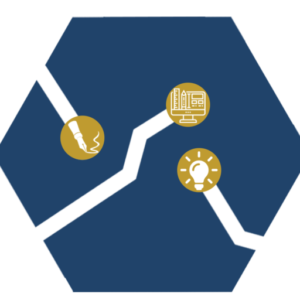This year promises to feature notable trends in eLearning that will reshape how organizations approach employee training. As technology advances, businesses increasingly recognize the pivotal role of eLearning in continuous skill development and adapting to evolving industry demands. From immersive learning experiences and personalized content delivery to the integration of generative artificial intelligence (AI), this year will witness a transformative shift in the world of learning and development (L&D). Staying current with emerging trends is key to creating a workforce that is not only competent, but also agile in navigating the modern business world.
 Generative artificial intelligence
Generative artificial intelligence
IBM defines Generative AI as “deep-learning models that can generate high-quality text, images, and other content based on the data they were trained on.” Think of OpenAI’s ChatGPT: you ask, “What are the top five family vacation spots in the US?” and ChatGPT quickly creates a list with a little information about each. It creates a simplified representation of the data on which it trained, but the list is not identical to that information.
Traditional upskilling resources — boot camps and workshops, for example — tend to focus on one specific topic and are often inflexible. Generative AI incorporates natural language processing (NLP) tools and offers in-depth technical documentation that caters to the user’s needs. Such tools tend to be flexible and customizable, allowing learners to tailor language and method of instruction to their own preferences.
Generative AI can also assist in the assessment of a user’s progress as an employee. Feedback tools allow organizations access to relevant metrics, providing personalized recommendations to improve individual performance.
 Emotional intelligence (EI)
Emotional intelligence (EI)
Peter Salovey and John Mayer coined the term “emotional intelligence” in 1990. Generally speaking, it is the ability to recognize and manage our emotions while understanding and influencing the emotions of others. While the importance of EI in training is nothing new, the way learners use it is changing. Empathy, self-awareness, self-regulation, and self-motivation are vital skills for people working together with advanced technologies. We need to think critically and ethically when using these new tools.
While incorporating generative AI into our L&D work is becoming a necessity, remember that AI lacks understanding of complex human interactions. Author Alicia D. Reece, PCC, says, “While AI brings advancements and efficiencies, it’s essential to recognize that the human touch, the ability to connect on an emotional level, is not something that AI can replicate.” Now more than ever, EI is a vital soft skill we need to embrace and improve in the new world of AI.
 “Resources not courses”
“Resources not courses”
Nick Shackleton-Jones a well-known learning expert, points out that, in the age of Google, over-reliance on courses is becoming counter-productive. Author of How People Learn, he created the “courses to resources” shift, also referred to as “resources not courses.”
Instead of creating long, time-consuming, and expensive courses, organizations must understand how we use information in the modern world: at the point of need. Training components are modular, easily assembled, disassembled, and reassembled into personalized configurations based on specific learning needs. A module is available to one worker as a stand-alone eLearn, while that same module is part of a larger plan for another individual. Updating a module is easier and more efficient than recreating long training videos.
Unlike traditional courses that tend to become outdated almost as soon as they are created, resource-centric models integrate the latest information, tools, and immersive learning tactics. Learners have access to up-to-date content, ensuring their knowledge is current and relevant in today’s fast-paced world. Users choose materials that suit their preferences, creating a more personalized and engaging learning experience.
Collaboration and knowledge sharing is also essential to this approach. Learners can contribute to the curation of resources, share insights, and engage in discussions around specific topics. The collaborative learning environment encourages a sense of community among learners and encourages a culture of continuous improvement.
 Immersive Learning
Immersive Learning
We have used immersive learning to master skills for a long time: fire drills and evacuation practices, for example. Thanks to ever-evolving technology, augmented reality (AR) and virtual reality (VR) now allow participants to practice and apply their skills in real-world situations in controlled environments. Using immersive learning, participants can “work in the job without being on the job,” as the Digital Learning Institute puts it.
AR blends and enhances part of our real world with digital content. Learners only need a mobile device, usually a smartphone, to access videos, images and even 3D models projected onto our lived-in environment. Pokémon Go is probably the most famous example of AR.
VR is an entirely immersive experience the learner accesses through a headset. These headsets can be combined with other devices, such as headphones or hand controllers. These help the user navigate the training. The headset is essential, as it allows users to see and hear as if they are in a real situation, helping them mentally and emotionally feel it. While VR tends to get more “coolness” vibes, AR is much more accessible, as it only needs a smartphone.
Adding immersive education to digital learning allows learners to actively participate and learn from the scenario in a risk-free environment. Learners using these tools tend to be more focused on learning, allowing them to retain knowledge and skills better. A study by PwC, a leading professional services firm, shows that 40 percent of VR learners improved their confidence when compared to classroom learners. Virtual learners also completed training four times faster than their colleagues in classroom training, while four times more focused during training than their eLearning peers.
 Gamification
Gamification
Gamification is changing how organizations approach L&D. In the past, traditional passive training methods – reading written materials, for example – often bore and do not engage learners, resulting in poor retention and performance. However, participants in game-based learning show an 83 percent increase in motivation compared to traditional training. And it’s fun!
But it’s about more than fun. Games are naturally engaging, and simulations, puzzles, and other interactive learning experiences tend to make learners feel more invested and connected to their training, leading to improved knowledge retention. Gamification also provides organizations and learners with immediate feedback and measurable progress. Users can practice and redo the game until they are happy with their results – another strategy to improving information retention.
Gaming can also be a team-building activity. Encouraging team members to play together helps develop collaboration while individuals learn and practice new skills and strategies, improving communication and cooperation abilities. Such improvements foster increased productivity and better work performance.
 Personalized learning
Personalized learning
We expect the trend in personalized learning experiences to balloon in 2024. AI and machine learning (ML) algorithms allow eLearning platforms to evaluate and analyze individual learner data, creating customized learning experiences. Due to rapid technological advances, personalized learning experiences are in high demand for maximizing the efficiency and success of training initiatives.
Real-time feedback allows learners to immediately see and learn from their mistakes, helping to reinforce concepts. Participants can track their progress, set goals, and access content specifically made for their needs thanks to individualized learning experiences and profiles. These learning platforms track every interaction, and the data is used to gain insights into that individual’s behavior, helping L&D see where more training may be necessary. NLP can be integrated into these eLearning platforms, helping learners participate in more natural and interactive trainings. NLP can even power chatbots and virtual assistants that offer instant support to make for an engaging experience.
 Microlearning
Microlearning
Microlearning, sometimes called nano learning, is a teaching method that delivers information in small, frequent chunks, typically under 10 minutes long but can be as short as a minute. Instead of traditional long-form training sessions, microlearning breaks down information into short, individual units. These bite-sized learning units address specific learning objectives or provide targeted information on a particular topic. They use a mix of elements, such as video, audio, text, and infographics. This approach is particularly well-suited for on-the-job training, continuous learning, and addressing specific learning needs efficiently.
Microlearning is delivered through a variety of digital formats, making it easily accessible to learners on different devices. Learners access content at their own pace and convenience, making it flexible for individuals with different learning preferences and schedules. In addition, the concise and focused nature of microlearning helps maintain learner engagement by avoiding information overload. Small bits of content cater to today’s shorter attention spans, leading to better retention.
The short duration of these modules allows learners to acquire specific information or skills without investing much time. Repurposing current training into new microlearning snippets saves money and time and allows for easier updates and edits. According to learning expert Ray Jimenez, microlearning courses can be created in 300 percent less time and at 50 percent less cost than traditional eLearning courses.
 Final Thoughts
Final Thoughts
Today’s eLearning trends reflect the quickly evolving needs of organizations and their workforce. Embracing immersive technologies, personalized learning experiences, and AI underscores an organization’s commitment to continuous skill development and flexibility. All the elements we’ve discussed will combine to not only meet today’s challenges but prepare us for unseen opportunities and uncertainties of tomorrow. As we move into the future, staying in tune with these trends is key for companies seeking not just to survive, but thrive.
Related Blogs
AI Tools Save Time — But Have Shortcomings
Why Outsource Instructional Design?
Resources
“About Nick Shackleton-Jones.” Shackleton Consulting. Accessed 1/23/24. https://shackleton-consulting.com
Apostolopoulos, Aris. “The 2019 Gamification at Work Study.” Talent LMS. 8/19/19. Accessed 1/19/24. https://www.talentlms.com/blog/gamification-survey-results
Chambers, Emma. “Definition Of A Learning Experience.” eLearning Industry. 9/21/20. Accessed 1/17/24. https://elearningindustry.com/definition-of-a-learning-experience
Jakob, Roman. “Game On! How Gamification Can Transform Corporate Training.” Training Industry. 6/19/23. Accessed 1/18/24. https://trainingindustry.com/articles/content-development/game-on-how-gamification-can-transform-corporate-training
Kwakwa, Nana. “Emotional Intelligence.” Tufts University. Accessed 1/23/24. https://sites.tufts.edu/eeseniordesignhandbook/2014/emotional-intelligence
Ma, Nhon. “How Generative AI Can Help Engineers Upskill.” BuiltIn. 12/7/23. Accessed 1/23/24. https://builtin.com/software-engineering-perspectives/upskilling-with-generative-AI
Martineau, Kim. “What is generative AI?” IBM. 4/20/23. Accessed 1/18/24. https://research.ibm.com/blog/what-is-generative-AI
“PwC’s study into the effectiveness of VR for soft skills training.” PwC. Accessed 1/22/24. https://www.pwc.co.uk/issues/technology/immersive-technologies/study-into-vr-training-effectiveness.html
Reece, Alicia D., PCC. “The Truth About Emotional Intelligence & AI: Thriving in an AI-Powered Era.” LinkedIn. 8/17/23. Accessed 1/19/24. https://www.linkedin.com/pulse/truth-emotional-intelligence-ai-thriving-ai-powered-d-reece-pcc
Scott, John, PhD. “3 Big L&D Trends for 2024.” Training Industry. 12/1/23. Accessed 1/19/24. https://trainingindustry.com/articles/strategy-alignment-and-planning/3-big-ld-trends-for-2024
Singh, Harvey. “The Top eLearning Trends for 2024: Personalized Learning Paths.” Instancy. Accessed 1/23/24. https://www.instancy.com/the-top-elearning-trend-for-2024-personalized-learning-paths
“The meaning of emotional intelligence.” The Last 8% Culture System. Accessed 1/22/24. https://www.ihhp.com/meaning-of-emotional-intelligence
“What is Immersive Learning? The future of Online Learning.” Digital Learning Institute. 5/30. Accessed 1/23/24. https://www.digitallearninginstitute.com/blog/what-is-immersive-learning
“What Is Microlearning?” Accessed 1/22/24. https://www.matcgroup.com/business/what-is-microlearning
“What is Microlearning — and What are its Advantages?” Beaconlive.com. Accessed 1/22/24. https://www.beaconlive.com/blog/microlearning-benefits



